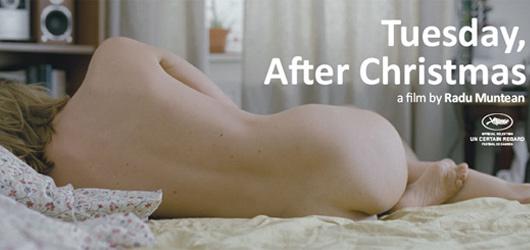Retro IONCINEMA.com
48th NYFF 2010: Radu Muntean’s Tuesday, After Christmas
The strongest arc of the film is given to Paul’s wife, played by Mirela Oprisor (Mimi Branescu’s real life wife). For the first half of the film, she is portrayed as pretty boring and almost drab in the way she’s settled into life as a mom, however, once Paul tells her about his girlfriend, she proceeds to light up and dominate the screen for the rest of the film. Muntean maintains balance between the characters here so well. The big knock on her would be that she took any kind of sexiness or excitement out of their relationship, and Paul craved it. Once she hears this news though, she’s very empowered and damn sexy.
Tuesday, After Christmas, director/co-writer Radu Muntean’s very strong entry into the recent streak of well-regarded Romanian films (4 Months, 3 Weeks, 2 Days, The Death of Mr. Lazarescu, Police, Adjective to name a few), is a case of a lot being done with a little. It’s hard to give a bottom line verdict because of that. Approaching the negative first might actually be more efficient, because there is much more positive here.

The only problem with this film is that the subject matter is, while topical and relevant to just about anyone, we can tag it as plain. Tuesday, After Christmas is the story of Paul, a 40-something married man with a daughter (around eight years old) who falls in love with another woman and must choose between his wife and girlfriend. Not exactly groundbreaking stuff. Muntean does not complicate the premise more than that, and it’s difficult to say whether that is good or bad.

The film is a voyeuristic look into the factors that go into this decision, how Paul goes about making it, and how it affects those around him. Stripping things down to the basics on the one hand provides the vehicle for all of the films strengths, notably its style and performances, but also makes the narrative a little trite. Specifically, yes this is a profound dilemma, but it is not a new one. It has been examined in every medium basically as long as stories have been told. That being said, this is a very good presentation of the material, albeit overly familiar and hardly shocking.
The entire film is made up of long scenes that unfold in one take. Muntean describes the shooting as very difficult, requiring much preparation including a three week rehearsal period with the entire crew, however the edit took only about twenty hours and six days after production they had a cut that included English subtitles, a color correct and sound mix.
Muntean says that this approach was based on a principal that “the camera should not be a character,” and instead “an observer.” In his discussion, he came dangerously close to describing the quest for objectivity, without ever using the word thankfully. Indeed the lack of cutting does give the scenes a naturalistic quality, making the unfolding of the action both raw and sparse in very good ways.
It’s not as if he uses his camera like that of a Bravo network reality show cameraman though. Whether he wanted to or not, his camera was a paintbrush, as he pointed our attention and glances to specific elements of the mise en scene. For example, there is a reason he does not show the wife in an entire scene as Paul massages her feet while they talk. The opening scene, featuring a post-coital Paul and his girlfriend, beautifully, slowly and deliberately reveals the intimacy between Paul and his girlfriend. Muntean’s camera creates a pace to the scene by withholding their bodies from us, slowly exposing them through shifting the frame as well as choreographing the actors movements.
I believe we have different definitions of the camera functioning as a character. I’m much more from the Rudolf Arnheim school, who puts major emphasis on the power of framing and camera movement. I interpret Muntean as meaning that the camera as a character refers more to heavily stylized, “poetic” cinema, such as POV cam and cutting to close-ups.
Despite my disagreeing with Muntean’s description of his camera-work, I consider it to be marvelous. The film is truly beautiful. It features a great marriage of choreography and framing, with lighting and production design simply meant to be as naturalistic as possible. Nothing was improvised; they rehearsed for a month beforehand, and stuck to the script. The DP and actors had to be very in synch. Muntean admitted to having trepidation about putting so much trust in his actors, but it worked out thankfully.

The film strikes a nice balance between its three characters. Never do our sympathies shift too far or away to or from any one character. Some critics have argued that the two women are far too interesting as human beings to be with such a boring man like Paul, but I disagree. The casting of Mimi Branescu as Paul is dead on. This is a regular guy. In the film, he works as a loan adjuster of some kind at a bank, and guys like this, in real life, are not exciting nor too stylish or handsome, but here and there they can land a girl or two who are out of their league. Part of the tragedy of this film is that these two women invest so much of themselves in a guy who is immature, noncommittal, lacks self-confidence, and possibly empathy for others.
The girlfriend, played by Maria Popistasu, rides a rather consistent line without much arc, but is always compelling still in her performance. She sells the romance between them, being a strong independent woman. She never wants anything from him, she does not rely on him for emotional or financial support, and she never encourages him to leave his wife.
The strongest arc of the film is given to Paul’s wife, played by Mirela Oprisor (Mimi Branescu’s real life wife). For the first half of the film, she is portrayed as pretty boring and almost drab in the way she’s settled into life as a mom, however, once Paul tells her about his girlfriend, she proceeds to light up and dominate the screen for the rest of the film. Muntean maintains balance between the characters here so well. The big knock on her would be that she took any kind of sexiness or excitement out of their relationship, and Paul craved it. Once she hears this news though, she’s very empowered and damn sexy.
The last thing to discuss in this film is its politics — or lack of politics for that matter. This is the only Romanian film in recent memory that I’ve seen that has no political message. Muntean discusses that had he made this in before 1989, it would probably be more affected by the state of his country, but now he has more freedom and can focus on the human relationships alone.
The “myth of capitalism” is something that did influence him though. Tuesday, After Christmas is all about choices. Capitalism tells us that we have many choices. This is the story of a guy who doesn’t really have a good choice though. His love for his wife never ended really, but he just felt compelled to investigate his new love as well. He cannot maintain his relationship with his wife though while doing that, so he needs to abandon one love for another. Muntean insists this is not allegory though—its strictly about intimacy.
Tuesday, After Christmas completes a very nice picture of intimacy and being trapped in prisons we build for ourselves. Sure, it’s not bringing up anything we have not seen before. It’s brilliant execution and minor changes to the formula really help distinguish it though. There are no bad guys here, just bad situations. And really nice camerawork.
Tuesday, After Christmas will be released via Lorber Films in May of 2011 at the Film Forum. Here are the screen times for Tuesday, After Christmas at the NYFF.



























